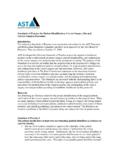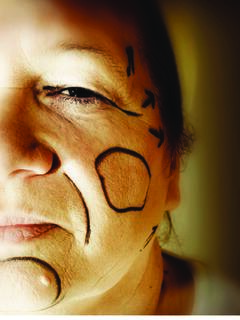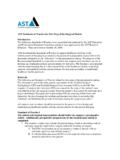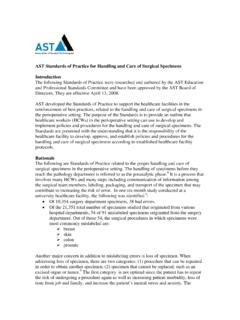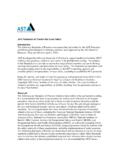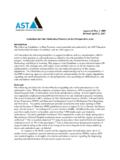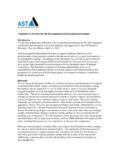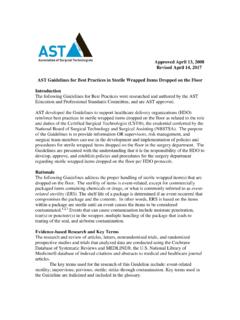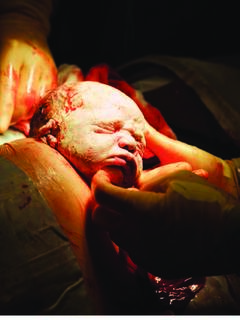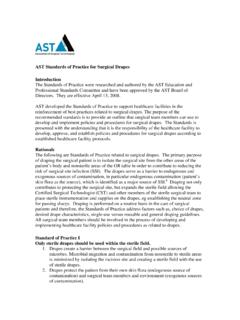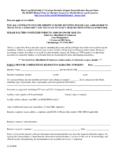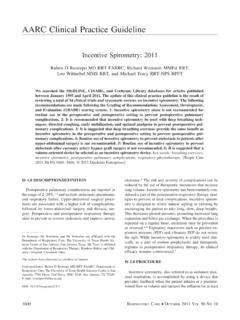Transcription of Standard Surgical Positioning - Association of …
1 AST Standards of Practice for Surgical Positioning Introduction The following Standards of Practice were researched and authored by the AST Education and Professional Standards Committee and have been approved by the AST Board of Directors. They are effective April 1, 2011. AST developed the Standards of Practice to support healthcare facilities in the reinforcement of best practices, related to Positioning the Surgical patient on the OR. table. The purpose of the Standards is to provide information that healthcare workers (HCWs) in the perioperative setting can use to develop and implement policies and procedures for Positioning the Surgical patient on the OR table. The Standards are presented with the understanding that it is the responsibility of the healthcare facility to develop, approve, and establish policies and procedures for Positioning the Surgical patient on the OR table, according to established healthcare facility protocols.
2 Rationale The following are Standards of Practice related to Surgical Positioning of the patient. The goal of the Surgical position is to provide optimal visualization of, and access to, the Surgical site that causes the least physiological compromise of the patient, while also protecting the skin and joints. When the patient has been administered anesthetic agents, the ability for the patient to communicate pain and pressure to the Surgical team has been eliminated; therefore, the team now becomes responsible for the patient to ensure the Positioning has been conducted in a safe manner, and the integumentary, musculoskeletal, respiratory and circulatory system functions have been preserved. The three components of safe Positioning of the Surgical patient on an OR table include knowledge, planning and teamwork. The team should be knowledgeable in applying the principles of patient Positioning in the OR, including attention to safety principles, because they pertain to the unique physiological qualities of each patient and the position itself that will be implemented.
3 Planning and teamwork go hand-in-hand and their importance cannot be overemphasized. Planning involves communication and cooperation among the team in order to anticipate specific patient challenges, eg patient is obese, has COPD or rheumatoid arthritis, or has a total hip implant. If planning is done correctly, the team members will coordinate their efforts, when the patient is transported into the OR to avoid last minute troubleshooting. It also enables the team to anticipate transporting and Positioning the equipment that will be required; confirming the equipment is in working order prior to the Surgical procedure; and ensuring that all multiple parts of the Positioning device fit together properly, if applicable. Teamwork is reinforced by ensuring an adequate number of trained personnel are assisting to effectively and safely position the patient; and each team member knows his/her duties during the patient Positioning .
4 By following these Recommended Standards of Practice, the Surgical team can reduce the chances of patient complications, related to Positioning as well as contribute to preventing team members suffering a musculoskeletal injury. Surgery department personnel should be involved in the process of developing and implementing healthcare facility policies and procedures for Positioning the patient on the OR table. Standard of Practice I. The Surgical team should be familiar with the goals of achieving safe and effective Positioning of the Surgical patient. 1. The goals of Positioning the Surgical patient are ensuring patient comfort and dignity; maintaining homeostasis; protecting anatomical structures and avoiding complications and injuries; promoting access to the surgery site; promoting access for the administration of IV fluids and anesthetic agents; and promoting access of OR Surgical equipment. A. Patient comfort, when using general anesthesia or when the patient is conscious, is important toward decreasing any undue physical and/or psychological stress.
5 When the patient is unconscious, a good practice is to treat the patient as if he/she was Additionally, it may be necessary to rehearse the Surgical position with the patient prior to surgery to confirm, it is not placing any undue physical stress on the B. patients , in particular pediatric patients , feel vulnerable and often helpless on the day of surgery and must place their trust in a Surgical team who are strangers. The Surgical team should make all efforts to minimize the exposure of the patient for purposes of respect, even if the patient will be under general anesthesia. C. The position should minimally interfere with the homeostasis of the body, eg respirations and circulation. Also, minimizing exposure of the body contributes to maintaining the normal body temperature of the patient. D. The Surgical team must be acutely aware of protecting the anatomical structures of the patient's body to avoid complications and injuries, including protection of skin, muscles and nerves, extremities including digits, and spine.
6 Additionally, the Surgical team must protect the patient from pressure sores, diathermy burns and tourniquet injuries. (See below for specific Recommended Standards that address these items in detail). E. The patient position should promote access to the surgery site without having to use a position that places undue stress on the body. F. The patient position should promote access to IV sites for the administration of medications, fluids, blood and blood products and anesthetic agents. G. The patient position should promote the ability to position Surgical equipment (eg C-arm, operating microscope, laser, Surgical robot) for ease of use by the Surgical team. Standard of Practice II. During preoperative planning for a Surgical procedure, the Surgical technologist and other Surgical team members should be informed of specific patient physiological factors that can affect the Positioning procedure. 1. The Surgical technologist should have the information pertaining to the preoperative physical assessment of the patient in order to anticipate precautions that must be taken during patient Positioning .
7 A. Patient preoperative assessment factors to be taken into consideration include: Age Height Weight Skin integrity Ranges of motion Preexisting conditions, eg allergies including latex; circulatory, respiratory, immune systems; neurological pathologies;. nutritional condition Mental competence, eg congenital disorders such as Down's syndrome; brain damage due to injury or disease Prosthetics Implanted devices, eg total joint implants; plates and screws;. pacemaker External devices, eg indwelling catheters; ostomy bags B. Surgical procedure preoperative assessment factors to be taken into consideration include: Surgical procedure to be performed Estimation of the length of the procedure Surgeon's and anesthesia provider's preferred Surgical position Standard of Practice III. Based upon the preoperative patient assessment and Surgical procedure, the Surgical technologist should anticipate the type of OR table and equipment that is needed.
8 1. The Surgical technologist should collaborate with the Surgical personnel and healthcare facility purchasing personnel in evaluating and purchasing OR tables and Positioning equipment. A. The surgery and purchasing personnel should analyze the types of Surgical procedures performed at the facility, patient population, manufacturers'. recommendations and published research to determine the OR tables and equipment that best meets the needs of the surgery department. B. The following essential factors should be taken into consideration when purchasing OR tables:19. Stable base Easy to maneuver and lock into place Easily adjusts into all positions, eg height, Trendelenburg, reverse Trendelenburg, lateral tilt, central break Easy-to-add Positioning equipment and adjust, eg armboards, stirrups, kidney rests, move head section to foot of OR table Radiolucent to allow taking X-rays or using fluoroscope Able to safely support patients .
9 Based on analysis of types of Surgical procedures performed and patient population, the surgery and purchasing personnel should request the manufacturer to provide information concerning the maximum patient weight the OR table can safely support. It may be necessary to purchase heavy-duty OR tables that can support up to 1,000 pounds. Easy to clean C. One of the most important safety factors that should be taken into consideration when purchasing OR tables is the mattresses and ability to evenly distribute the body pressure to prevent circulatory disturbances and pressure ulcers at the bony prominences. (1) The routine mattress is foam covered with nylon or vinyl. An alternative is the gel mattress. Research results have not provided a definitive answer regarding which type is best for preventing intraoperative skin injuries and pressure ulcers. The surgery and purchasing personnel should request the manufacturer to provide information including research that has been performed on the mattresses being considered for purchase.
10 Additionally, the personnel should be allowed by the manufacturer to use the mattresses on a test basis to determine which performs the best and meets the needs of the facility and patients . However, the surgery and purchasing personnel should base their decisions on the following factors: Based upon analysis of Surgical procedures performed, mattresses are appropriate for the requirements of the various Surgical positions, including availability of different sizes and foam thickness;. Made of resilient, long-lasting material, including no breakdown when cleaned with disinfectant agents;. Radiolucent (if surgery department performs procedures that require intraoperative imaging studies);. Moisture resistant;. Fire retardant;. Nonallergenic, in particular, no presence of latex in material;. D. Even if the surgery department does not perform bariatric Surgical procedures, it is still required that the department be prepared for performing other types of Surgical procedures on obese patients .
